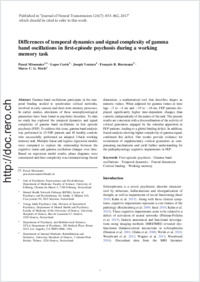Differences of temporal dynamics and signal complexity of gamma band oscillations in first-episode psychosis during a working memory task
- Missonnier, Pascal Unit of Psychiatric Neuroscience and Psychotherapy, Department of Medicine, Faculty of Science, University of Fribourg, Switzerland - Mental Health Network Fribourg (RFSM), Sector of Psychiatry and Psychotherapy for Adults, Marsens, Switzerland
- Curtis, Logos Young Adult Psychiatry Unit, Division of Specialized Psychiatry, Department of Mental Health and Psychiatry, Faculty of Medicine of the University of Geneva, University Hospitals of Geneva, Switzerland
- Ventura, Joseph Department of Psychiatry and Biobehavioral SciencesUCLA Department of Psychiatry, Los Angeles, USA
- Herrmann, François R. Department of Internal Medicine, Rehabilitation and GeriatricsUniversity Hospitals of Geneva, Switzerland
- Merlo, Marco C. G. Unit of Psychiatric Neuroscience and Psychotherapy, Department of Medicine, Faculty of Science, University of Fribourg, Switzerland
-
01.07.2017
Published in:
- Journal of Neural Transmission. - 2017, vol. 124, no. 7, p. 853–862
English
Gamma band oscillations participate in the temporal binding needed to synchronize cortical networks, involved in early sensory and short term memory processes. In earlier studies, alterations of these neurophysiological parameters have been found in psychotic disorders. To date no study has explored the temporal dynamics and signal complexity of gamma band oscillations in first episode psychosis (FEP). To address this issue, gamma band analysis was performed in 15 FEP patients and 18 healthy controls who successfully performed an adapted 2-back working memory task. Multiple linear and logistic regression models were computed to explore the relationship between the cognitive status and gamma oscillation changes over time. Based on regression model results, phase diagrams were constructed and their complexity was estimated using fractal dimension, a mathematical tool that describes shapes as numeric values. When adjusted for gamma values at time lags −3 to −4 ms and −15 to −16 ms, FEP patients displayed significantly higher time-dependent changes than controls, independently of the nature of the task. The present results are consistent with a discoordination of the activity of cortical generators engaged by the stimulus apparition in FEP patients, leading to a global binding deficit. In addition, fractal analysis showing higher complexity of gamma signal, confirmed this deficit. Our results provide evidence for recruitment of supplementary cortical generators as compensating mechanisms and yield further understanding for the pathophysiology cognitive impairments in FEP.
- Faculty
- Faculté des sciences et de médecine
- Department
- Médecine 3ème année
- Language
-
- English
- Classification
- Biological sciences
- License
-
License undefined
- Identifiers
-
- RERO DOC 305102
- DOI 10.1007/s00702-017-1728-5
- Persistent URL
- https://folia.unifr.ch/unifr/documents/305969
Statistics
Document views: 92
File downloads:
- pdf: 206
